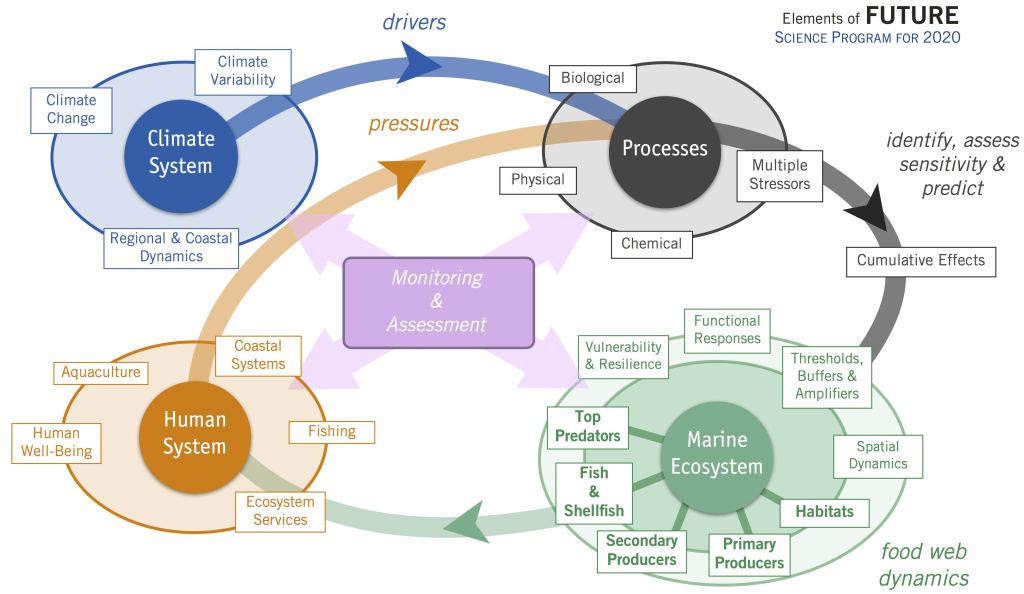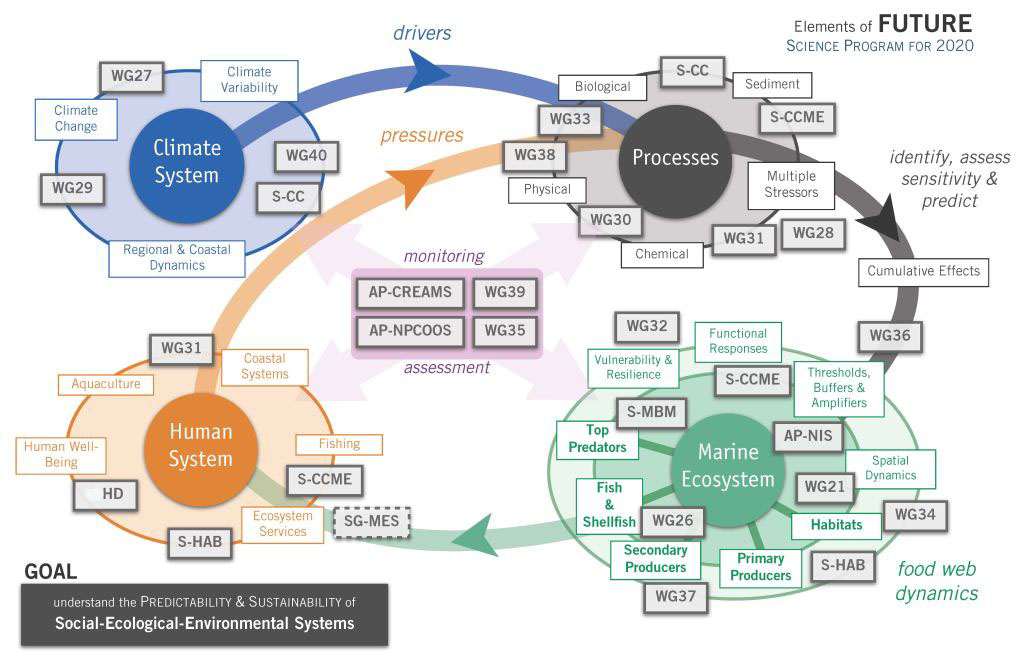- Acronym: FUTURE
- Established: Oct. 2009
- Research Themes and Implementation Objectives
- Organizational Structure
- FUTURE SSC
- NPESR—Next Iteration
- Materials and products
- FUTURE Early Career Scientist Award
The
FUTURE Science Plan
developed by the Science Plan Writing
Team (WT-FISP) under
the Study Group on Future Integrative Scientific Program(s)
(SG-FISP)
was approved in principle at the 2007 PICES Annual Meeting (October
2007, Victoria, Canada) and finalized in February 2008.

FUTURE Schematic of the North Pacific Social-Ecological-Environmental System (SEES) Framework that enables understanding of the combined system elements of the Climate System, Processes, Marine Ecosystem, and the Human System. Central to the understanding of these systems is integrated long-term and sustained monitoring and assessment, which is shown in purple in the center of the schematic. This framework enables the discovery of interactions among and across disciplinary dimensions to facilitate and understand large-scale ecosystem changes and resulting impacts both ocean-wide and on coastal communities.

This figure enhances the previous figure by placing specific Expert Groups created by PICES to examine specific pieces of the multidimensional and interdisciplinary puzzles that are common in large-scale multifaceted problems. Expert Groups include Working Groups (WGxx), Advisory Panels (AP-xxxx), Sections (S-xxxx) and sometimes Study Groups (SG-xxx) and Committees (C-xxxx). Each of these is placed within the SEES framework schematic where that particular Expert Group is most relevant and engaged (some in several locations). Each of these expert groups is clickable. Clicking on an Expert Group will take you to the home of the group, which provides details on their Terms of Reference, Goals, Objectives and Key Tasks, and provides information on membership, reports published, products produced, and sessions convened at annual meetings.
The FUTURE Program of PICES has successfully applied this schematic to four “case-studies” in the North Pacific. A paper (Bograd etal. In Press) has been accepted and will be available soon in Frontiers in Marine Science. The SEES approach fosters a common transdisciplinary language and knowledge base among diverse experts to enable the development of better integrated end-to-end models and was essential to the success in examining and understanding the case-studies.
FUTURE is an integrative Scientific Program undertaken by the member nations and affiliates of PICES to understand how marine ecosystems in the North Pacific respond to climate change and human activities, to forecast ecosystem status based on a contemporary understanding of how nature functions, and to communicate new insights to its members, governments, stakeholders and the public.
FUTURE evolved from research conducted by its predecessor, the PICES/GLOBEC Climate Change and Carrying Capacity (CCCC) Program, which had the goal of increasing understanding of climate influences on marine ecosystems. FUTURE continues a focus on understanding climate impacts on marine systems and places additional emphasis on coastal anthropogenic influences, ecosystem forecasting, and engaging a broad user community with interests in North Pacific ecological and climate information.
New EXPERT GROUPS (EGs) may be proposed, and if approved by Council, established to work on new tasks that require different expertise or focused effort.
WORKING GROUPS are established specifically to address components of FUTURE.
Working groups can be established by Scientific Programs, like FUTURE, or by one of the seven standing Scientific Committees of PICES. Working groups have clearly defined terms of reference, and are expected to complete their tasks within three, exceptionally four, years.
WG 35, Third North Pacific Ecosystem Status Report (WG-NPESR3)
(May 2016 – Nov. 2019)
WG 36, Common Ecosystem Reference Points across PICES Member Countries
(Nov. 2016 – Oct. 2019)
WORKING GROUPS that completed their terms of reference and were disbanded. (WG21, WG26, WG27, WG28, WG29, WG41 WG 40, Climate and Ecosystem Predictability
(Jul. 2017- PICES-2023))
SECTIONS have existed from prior to the establishment of the FUTURE Science Program.
Sections may have long durations, but must be reviewed by the parent committees at 3 year intervals, and may be approved to extend an additional 3 years. Terms of reference of sections may be revised as required to tackle emerging issues. Some PICES Sections have existed more than 16 years. Note: sections can be established by the Scientific Program or by one of the seven standing Scientific Committees of PICES.
ACTIVE SECTIONS
S-CCME,
Climate Change Effects on Marine Ecosystems
(Oct. 2011 – Oct. 2019)
is co-parented by the POC (Physical Oceanography and Climate), BIO (Biological Oceanography) and FIS (Fishery Science) Committees
S-HAB,
Ecology of Harmful Algal Blooms in the North Pacific
(Oct. 2003 – Oct. 2019)
is parented by the Marine Environmental Quality (MEQ) Committee
S-MBM,
Marine Birds and Mammals
(Oct. 2015 – Oct. 2020)
is parented by the BIO (Biological Oceanography) Committee
S-CC,
Carbon and Climate
(Oct. 2005 – Oct. 2019)
is co-parented by the POC (Physical Oceanography and Climate) and BIO (Biological Oceanography) Committees
One Section,
S-HD, Human Dimensions of Marine Systems
(Oct. 2011 – Oct. 2016)
which was originally active in FUTURE was disbanded as HD activities were elevated to the Human Dimensions Committee (HD) in Oct. 2016.
AP-NPCOOS, North Pacific Coastal Ocean Observing Systems (Oct. 2015 – Oct. 2020)
AP-CREAMS, CREAMS/PICES Program in East Asian Marginal Seas (Oct. 2005 – Oct. 2019)
AP-NIS, Marine Non-indigenous Species (June 2016 – Oct. 2020)
FUTURE is one of the highest priority activities of PICES for the next decade.
FUTURE Liaisons (pdf)
FUTURE is organized around three research themes that are best characterized as key questions:
- What determines an ecosystem’s intrinsic resilience and vulnerability to natural and anthropogenic forcing?
- How do ecosystems respond to natural and anthropogenic forcing, and how might they change in the future?
- How do human activities affect coastal ecosystems and how are societies affected by changes in these ecosystems?
Each of the key questions has a list of more specific questions that define an approach to address a research theme (see pp. 3-4 in the FUTURE Science Plan ).
The ultimate goal of FUTURE is to understand and communicate the future of North Pacific ecosystems and the potential impacts from human use . Implementation of FUTURE has two objectives (see p. 3 in the FUTURE Implementation Plan ):
- To increase understanding of climatic and anthropogenic impacts and consequences on marine ecosystems, with continued leadership at the frontiers of marine science;
- To develop activities that include the interpretation, clarity of presentation, peer review, dissemination, and evaluation of ecosystem products (e.g., status reports, outlooks, forecasts) and establish a process for engaging interested institutions and other recipients.
To address the FUTURE goal, there is growing awareness that variability in marine ecosystems is neither simple nor linear either within or across scales, with consequences from ecological disasters to unexpected benefits. Impacts can have a mixture of local, regional, basin and global-scale causes.
Scientific Steering Committee (FUTURE-SSC)
FUTURE-SSC Members information
Expert Groups:
The main activities of FUTURE are carried out by the existing expert groups (Sections, Working Groups , Advisory Panels , Study Groups) and new expert groups recommended by the Scientific and Technical Committees and initiated by the Science Board following the Rules of Procedure.
Developing a social–ecological–environmental system framework to address climate change impacts in the North Pacific
Frontiers in Marine Science, Vol. 6, Article 333
FUTURE Intersessional Meetings
FUTURE Workshops' products
2010
inter-sessional FUTURE workshop
August 16–18, 2010, at the Lotte Hotel World, in Seoul, Korea
2011
inter-sessional FUTURE workshop
April 26–28, 2011, at the East-West Center, Honolulu, Hawaii,
U.S.A.
FUTURE Expert Groups' products
Working Group: WG 27
North Pacific Climate Variability and Change
Working Group: WG 28
Development of Ecosystem Indicators to Characterize Responses to Multiple Stressors
Working Group: WG 29
Regional Climate Modeling
Working Group: WG 30
Assessment of Marine Environmental Quality of Radiation around the North Pacific
Working Group: WG 31 (no products reported yet)
Emerging Topics in Marine Pollution
Study Group: SG-SEES (no products reported yet)
Socio-Ecological-Environmental Systems
Section: S-CCME
Climate Change Effects on Marine Ecosystems